Cooperative Positioning Method of a Multi-UAV Based on an Adaptive Fault-Tolerant Federated Filter
Abstract
:1. Introduction
2. The Principle of the Federated Filter and Cooperative Positioning Scheme
2.1. The Principle of the Federated Filter
2.2. Multi-UAV Cooperative Positioning Scheme
3. Model of the Adaptive Fault-Tolerant Federated Filter
3.1. State Equation of the Adaptive Fault-Tolerant Federated Filter
3.2. Measurement Equation of Sub-Filters
3.2.1. Measurement Equation of Sub-Filter 1
3.2.2. Measurement Equation of Sub-Filter 2
4. Design of the Adaptive Fault-Tolerant Federated Filter
4.1. Fault Detection and Isolation
4.2. Adaptive Measurement Noise Matrix Adjustment
5. Simulation Verification and Analysis
5.1. Simulation Conditions Set
5.2. Simulation Results and Analysis
6. Conclusions
Author Contributions
Funding
Institutional Review Board Statement
Informed Consent Statement
Data Availability Statement
Conflicts of Interest
References
- Lee, H.-S.; Shin, B.-S.; Thomasson, J.A.; Wang, T.; Zhang, Z.; Han, X. Development of Multiple UAV Collaborative Driving Systems for Improving Field Phenotyping. Sensors 2022, 22, 1423. [Google Scholar] [CrossRef]
- Abbas, N.; Abbas, Z.; Liu, X.; Khan, S.S.; Foster, E.D.; Larkin, S. A Survey: Future Smart Cities Based on Advance Control of Unmanned Aerial Vehicles (UAVs). Appl. Sci. 2023, 13, 9881. [Google Scholar] [CrossRef]
- Xiong, F.; Li, A.; Wang, H.; Tang, L. An SDN-MQTT Based Communication System for Battlefield UAV Swarms. IEEE Commun. Mag. 2019, 57, 41–47. [Google Scholar] [CrossRef]
- Hu, C.F.; Zhang, Z.L.; Yang, N.; Shin, H.S.; Tsourdos, A. Fuzzy multiobjective cooperative surveillance of multiple UAVs based on distributed predictive control for unknown ground moving target in urban environment. Aerosp. Sci. Technol. 2019, 84, 329–338. [Google Scholar] [CrossRef]
- Chen, H.X.; Nan, Y.; Yang, Y. Multi-UAV reconnaissance task assignment for heterogeneous targets based on modified symbiotic organisms search algorithm. Sensors 2019, 19, 734–745. [Google Scholar] [CrossRef]
- Sun, F.; Wang, X.; Zhang, R. Task scheduling system for UAV operations in agricultural plant protection environment. J. Ambient. Intell. Humaniz. Comput. 2020, 21, 123–135. [Google Scholar] [CrossRef]
- Akhloufi, M.A.; Couturier, A.; Castro, N.A. Unmanned Aerial Vehicles for Wildland Fires: Sensing, Perception, Cooperation and Assistance. Drones 2021, 5, 15. [Google Scholar] [CrossRef]
- Zhen, Z.; Chen, Y.; Wen, L.; Han, B. An intelligent cooperative mission planning scheme of UAV swarm in uncertain dynamic environment. Aerosp. Sci. Technol. 2020, 100, 105826. [Google Scholar] [CrossRef]
- Wang, C.; Wang, J.; Wang, J.; Zhang, X. Deep-reinforcement-learning-based autonomous UAV navigation with sparse rewards. IEEE Internet Things J. 2020, 7, 6180–6190. [Google Scholar] [CrossRef]
- Wang, X.; Cui, N.; Guo, J. INS/VisNav/GPS relative navigation system for UAV. Aerosp. Sci. Technol. 2013, 28, 242–248. [Google Scholar] [CrossRef]
- Han, Z.; Guo, K.; Xie, L.; Lin, Z. Integrated relative localization and leader-follower formation control. IEEE Trans. Autom. Control. 2019, 64, 20–34. [Google Scholar] [CrossRef]
- Zhao, H.; Xiong, Z.; Shi, L.; Yu, F.; Liu, J. A robust filtering algorithm for integrated navigation system of aerospace vehicle in launch inertial coordinate. Aerosp. Sci. Technol. 2016, 58, 629–640. [Google Scholar] [CrossRef]
- Causa, F.; Fasano, G. Improved In-Flight Estimation of Inertial Biases through CDGNSS/Vision Based Cooperative Navigation. Sensors 2021, 21, 3438. [Google Scholar] [CrossRef]
- Xiong, J.; Xiong, Z.; Cheong, J.W. Cooperative positioning for low-cost close formation flight based on relative estimation and belief propagation. Aerosp. Sci. Technol. 2020, 106, 106068. [Google Scholar] [CrossRef]
- Chen, M.; Xiong, Z.; Liu, J.; Wang, R.; Xiong, J. Cooperative navigation of unmanned aerial vehicle swarm based on cooperative dilution of precision. Int. J. Adv. Robot. Syst. 2020, 17, 1729881420932717. [Google Scholar] [CrossRef]
- Chen, M.; Xiong, Z.; Xiong, J.; Wang, R. A hybrid cooperative navigation method for UAV swarm based on factor graph and Kalman filter. Int. J. Distrib. Sens. Netw. 2022, 18, 15501477211064758. [Google Scholar] [CrossRef]
- Tang, C.; Wang, Y.; Zhang, L.; Zhang, Y.; Song, H. Multisource Fusion UAV Cluster Cooperative Positioning Using Information Geometry. Remote Sens. 2022, 14, 5491. [Google Scholar] [CrossRef]
- Zhu, X.; Lai, J.; Chen, S. Cooperative Location Method for Leader UAV-Follower UAV Formation Based on Follower UAV’s Moving Vector. Sensors 2022, 22, 7125. [Google Scholar] [CrossRef]
- Wan, J.; Zhong, L.; Zhang, F. Cooperative Localization of Multi-UAVs via Dynamic Nonparametric Belief Propagation under GPS Signal Loss Condition. Int. J. Distrib. Sens. Netw. 2014, 10, 562380. [Google Scholar] [CrossRef]
- Xu, H.; Yu, D.; Sui, S.; Chen, C. An Event-Triggered Predefined Time Decentralized Output Feedback Fuzzy Adaptive Control Method for Interconnected Systems. IEEE Trans. Fuzzy Syst. 2023, 31, 631–644. [Google Scholar] [CrossRef]
- Yu, D.; Yang, M.; Liu, Y.; Wang, Z.; Chen, C. Adaptive Fuzzy Tracking Control for Uncertain Nonlinear Systems with Multiple Actuators and Sensors Faults. IEEE Trans. Fuzzy Syst. 2023, 31, 104–116. [Google Scholar] [CrossRef]
- Xiong, H.; Mai, Z.; Tang, J.; He, F. Robust GPS/INS/DVL Navigation and Positioning Method Using Adaptive Federated Strong Tracking Filter Based on Weighted Least Square Principle. IEEE Access 2019, 7, 26168–26178. [Google Scholar] [CrossRef]
- Yang, Y.; Liu, X.; Zhang, W.; Liu, X.; Guo, Y. A Nonlinear Double Model for Multisensor-Integrated Navigation Using the Federated EKF Algorithm for Small UAVs. Sensors 2020, 20, 2974. [Google Scholar] [CrossRef]
- Sidorenko, J.; Schatz, V.; Scherer-Negenborn, N. Decawave UWB Clock Drift Correction and Power Self-Calibration. Sensors 2019, 19, 2942. [Google Scholar] [CrossRef]
- Wu, X.; Su, Z.; Li, L.; Bai, Z. Improved Adaptive Federated Kalman Filtering for INS/GNSS/VNS Integrated Navigation Algorithm. Appl. Sci. 2023, 13, 5790. [Google Scholar] [CrossRef]
- Xu, J.; Xiong, Z.; Liu, J.; Wang, R. A Dynamic Vector-Formed Information Sharing Algorithm Based on Two-State Chi Square Detection in an Adaptive Federated Filter. J. Navig. 2019, 72, 101–120. [Google Scholar] [CrossRef]
- Wang, Q.; Cui, X.; Li, Y.; Ye, F. Performance Enhancement of a USV INS/CNS/DVL Integration Navigation System Based on an Adaptive Information Sharing Factor Federated Filter. Sensors 2017, 17, 239. [Google Scholar] [CrossRef]
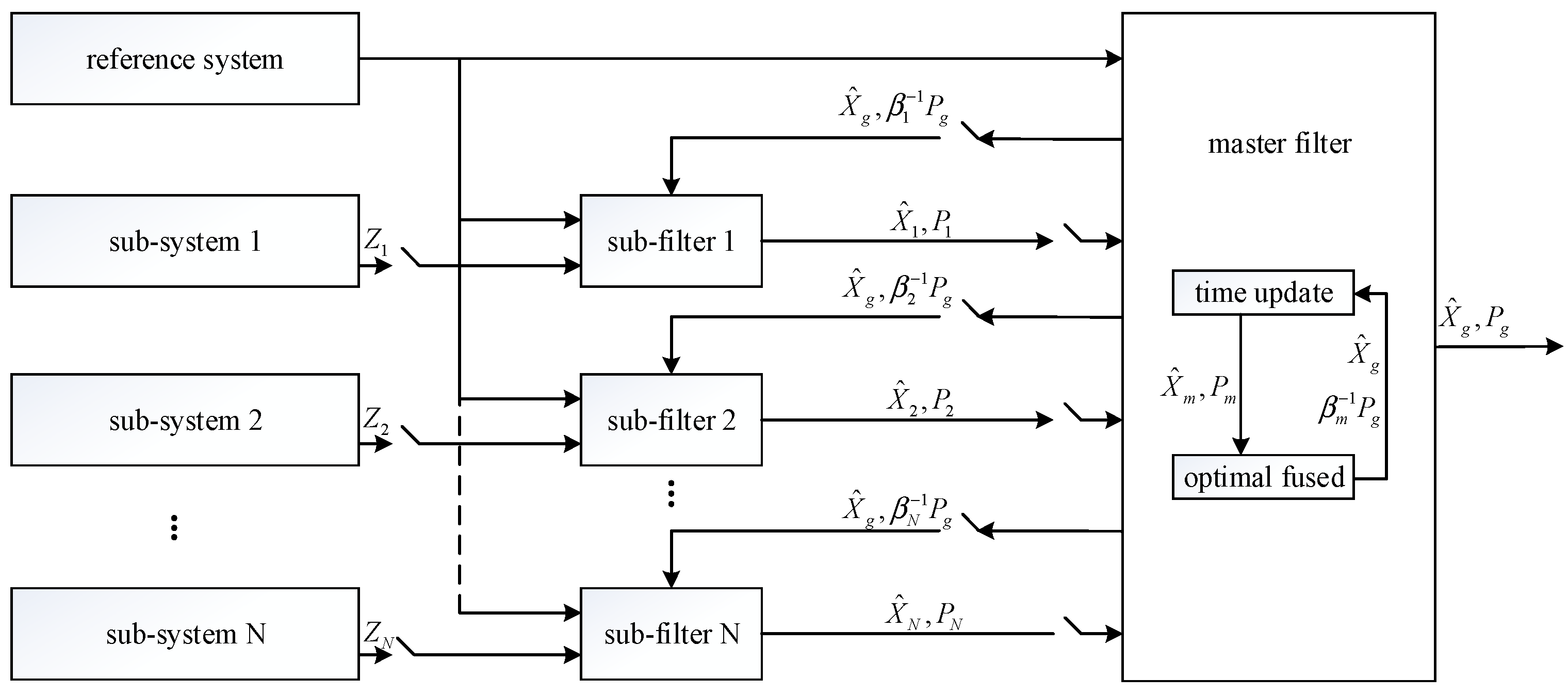
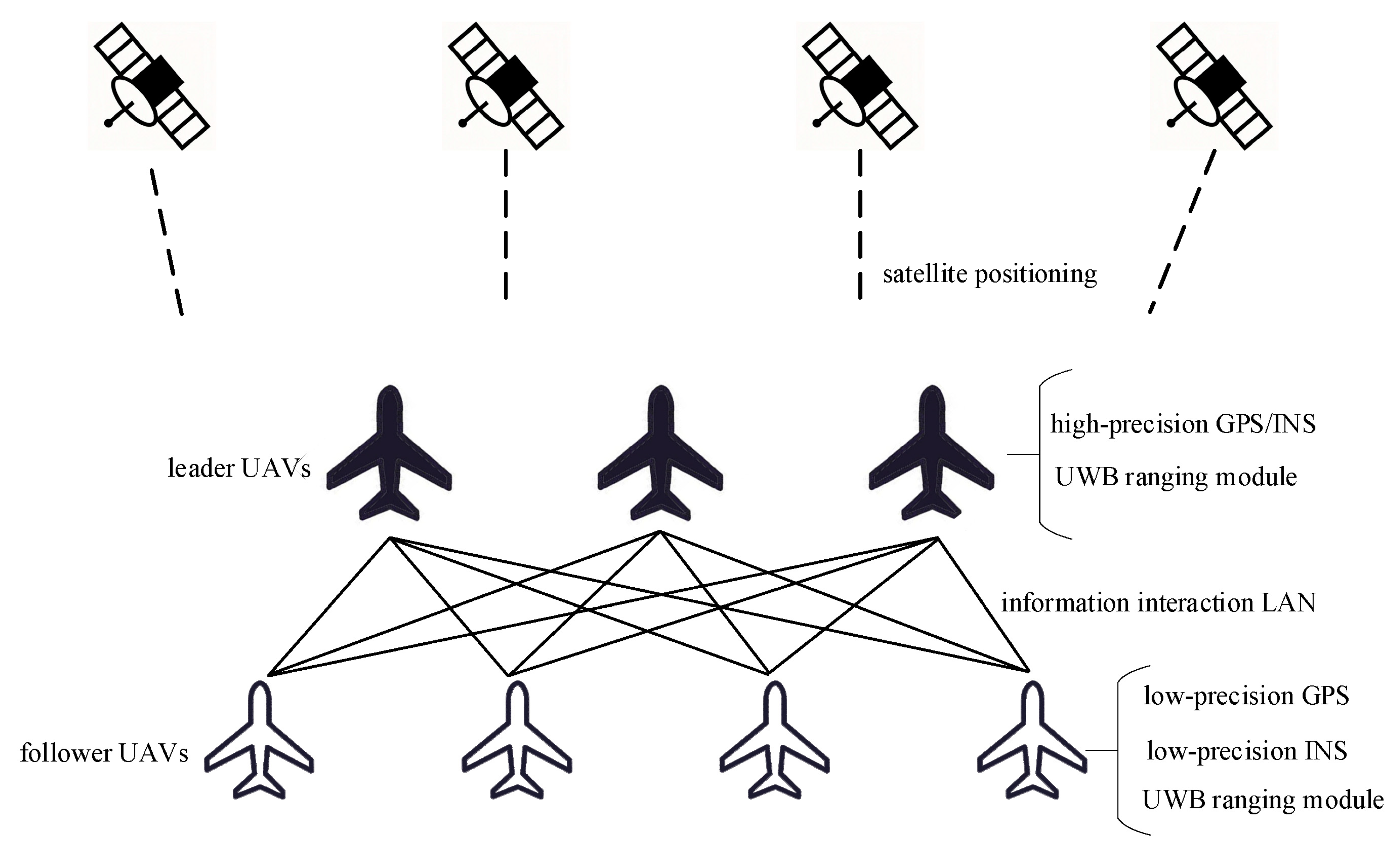
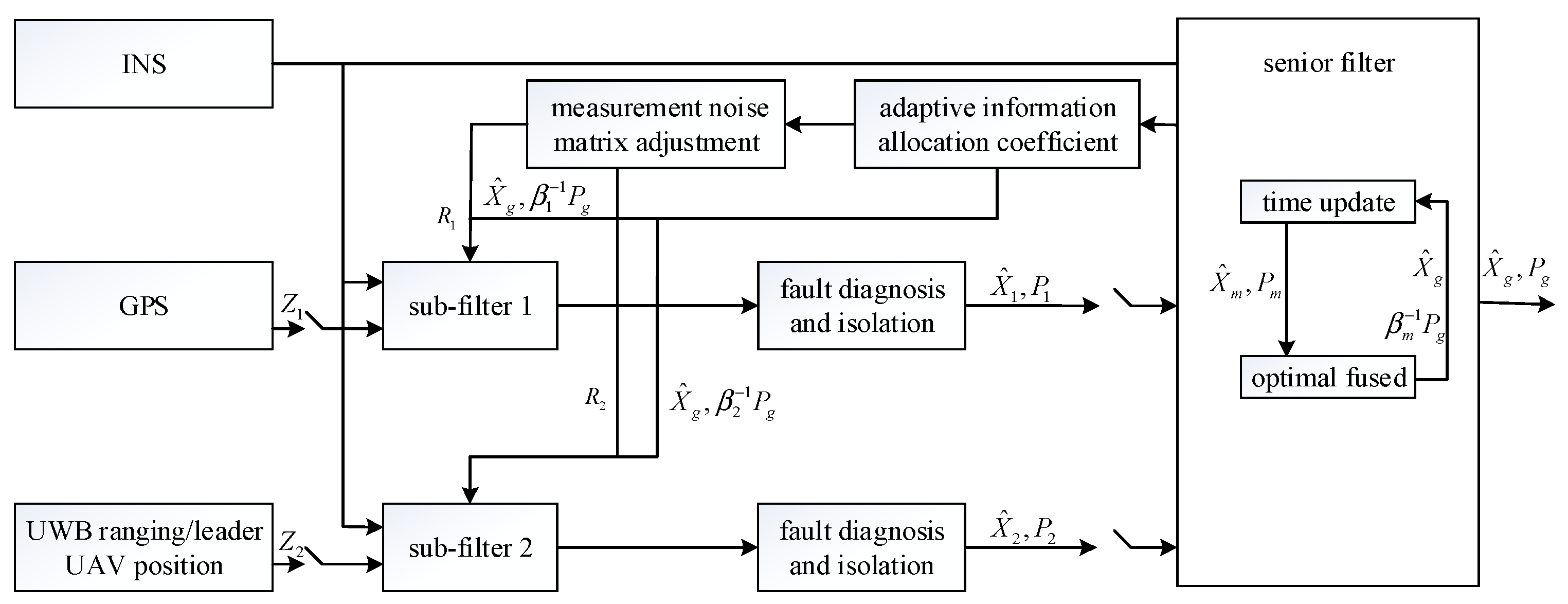

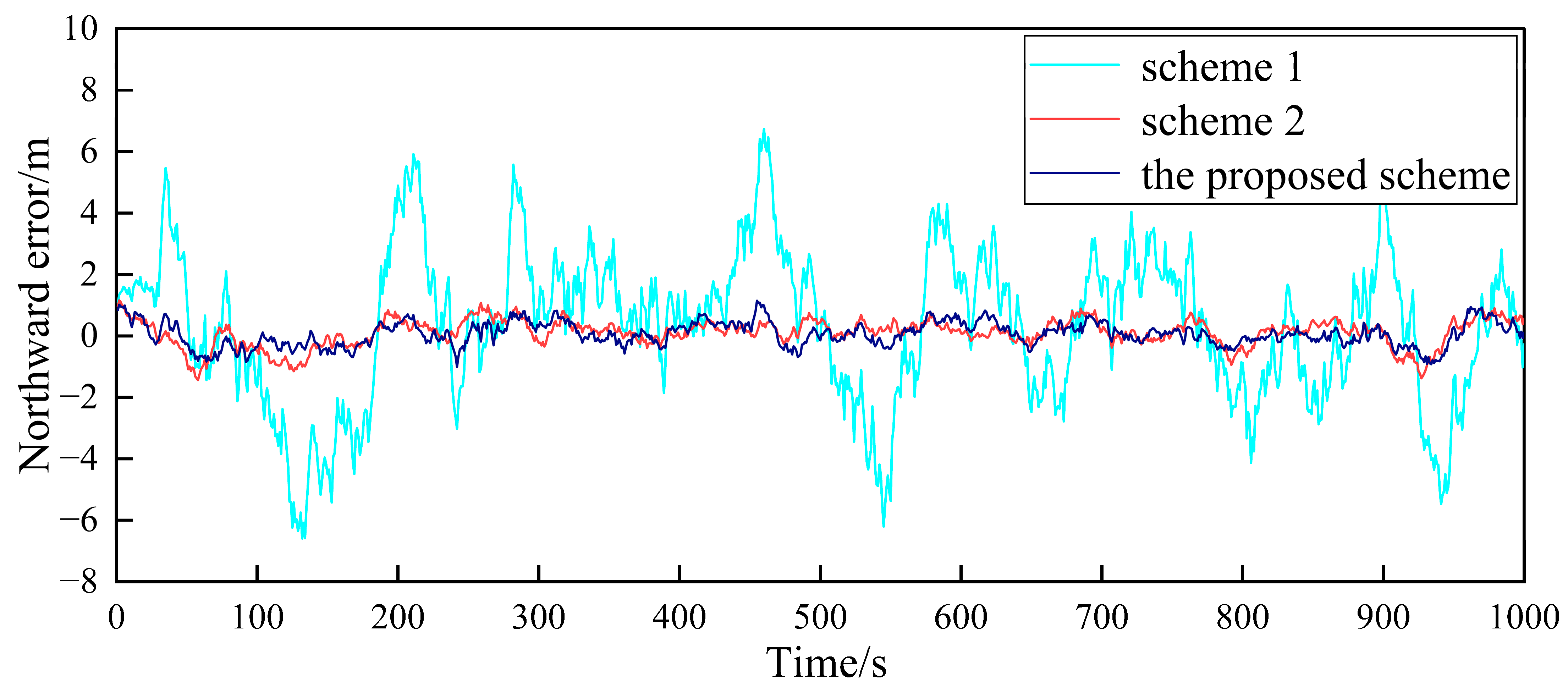
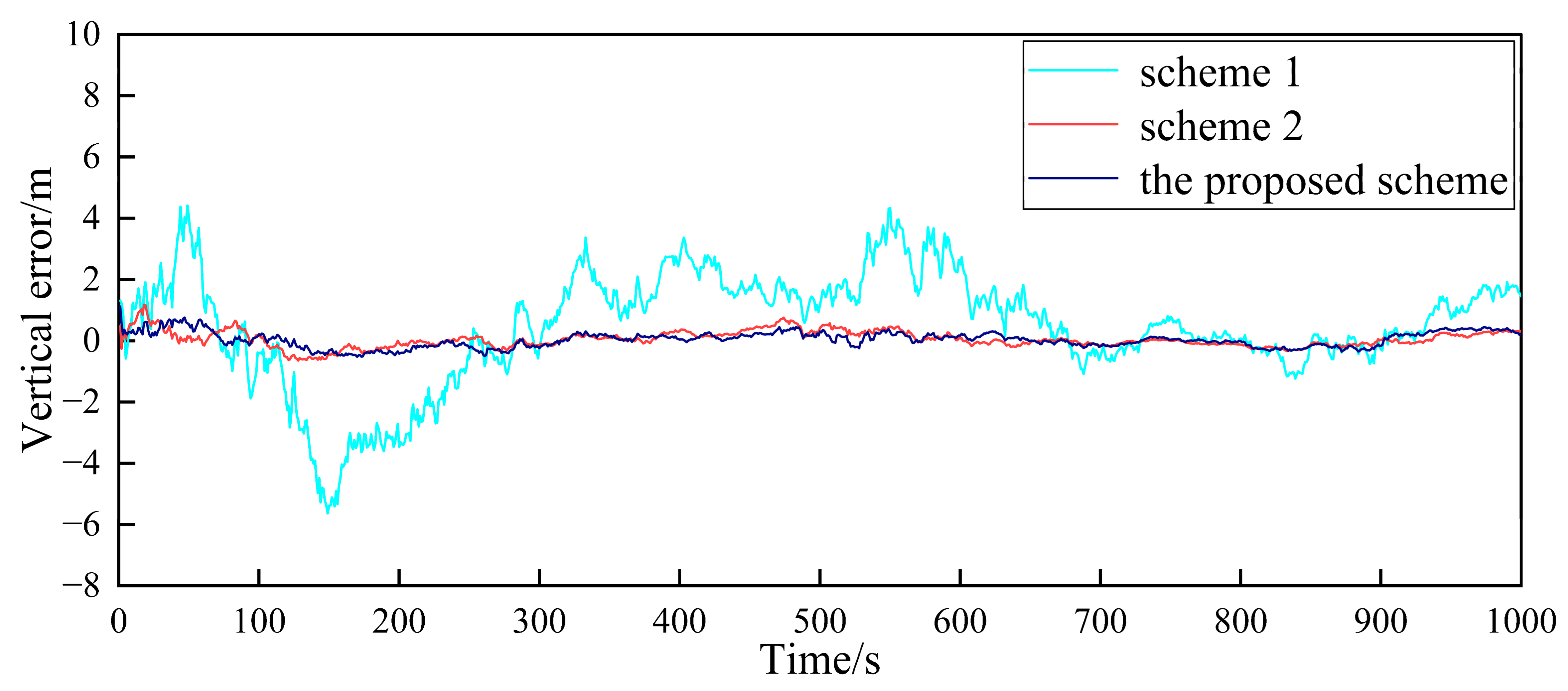

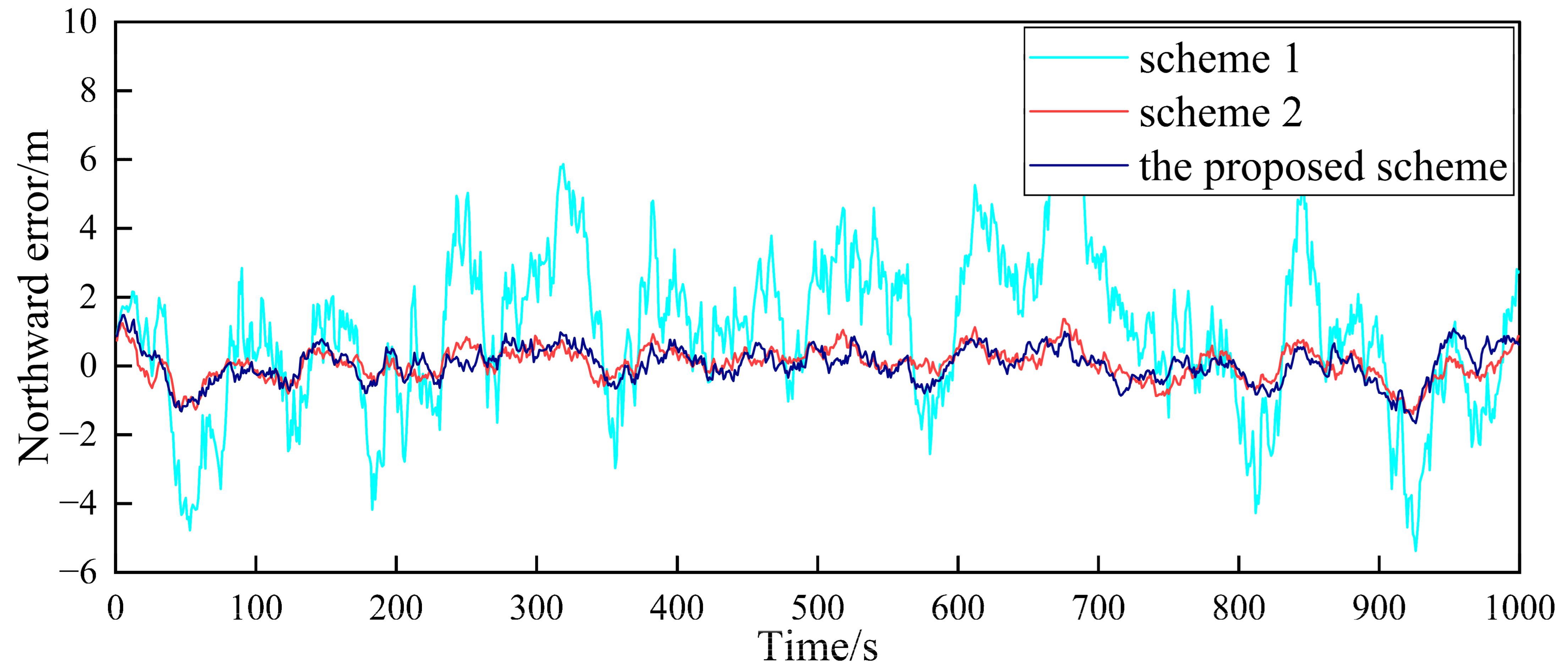
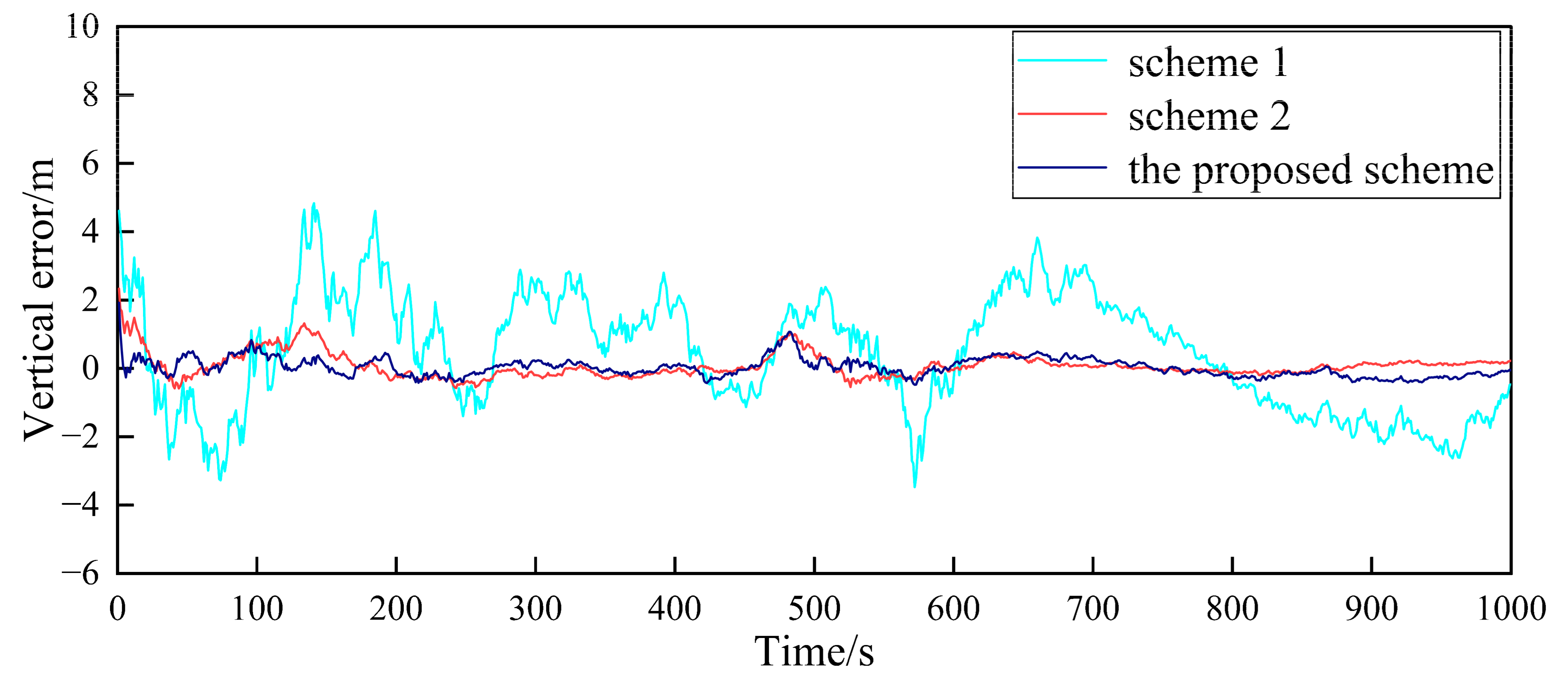
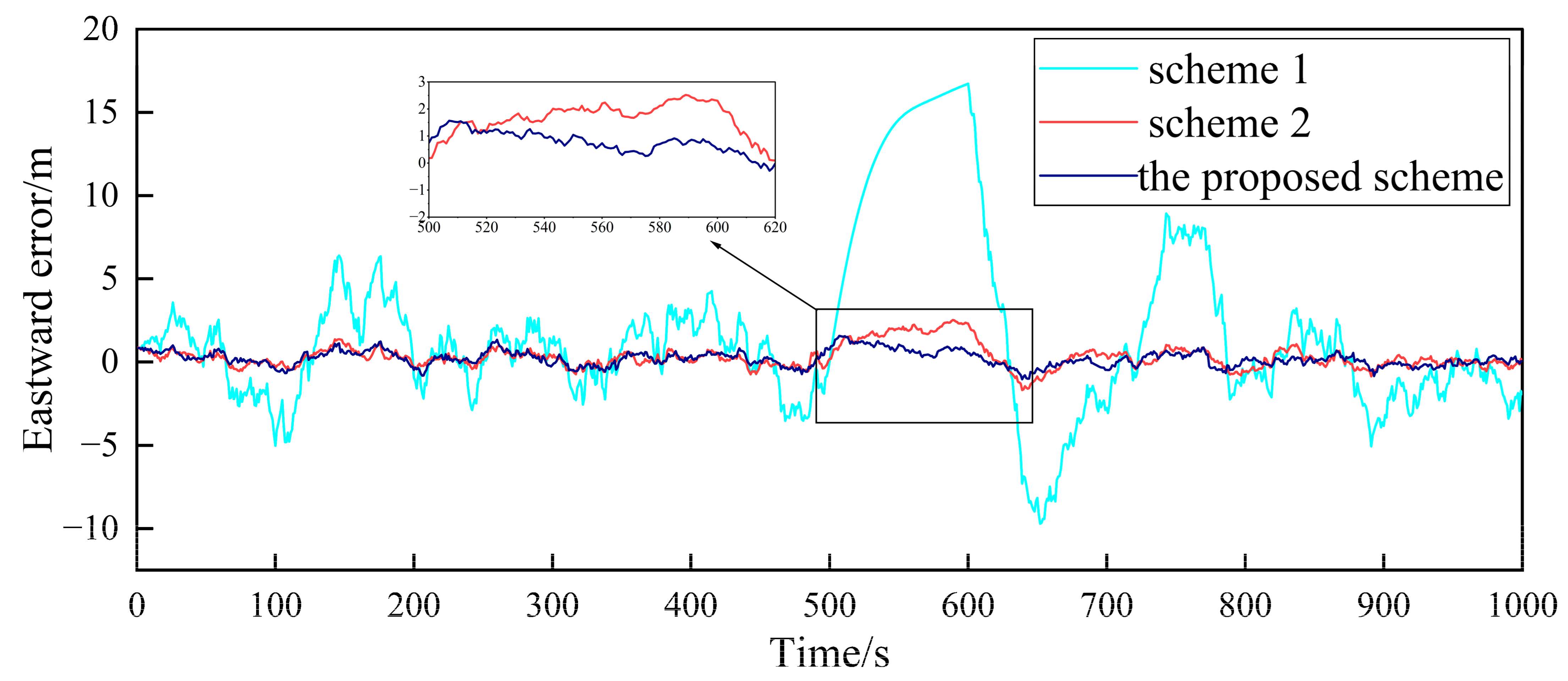

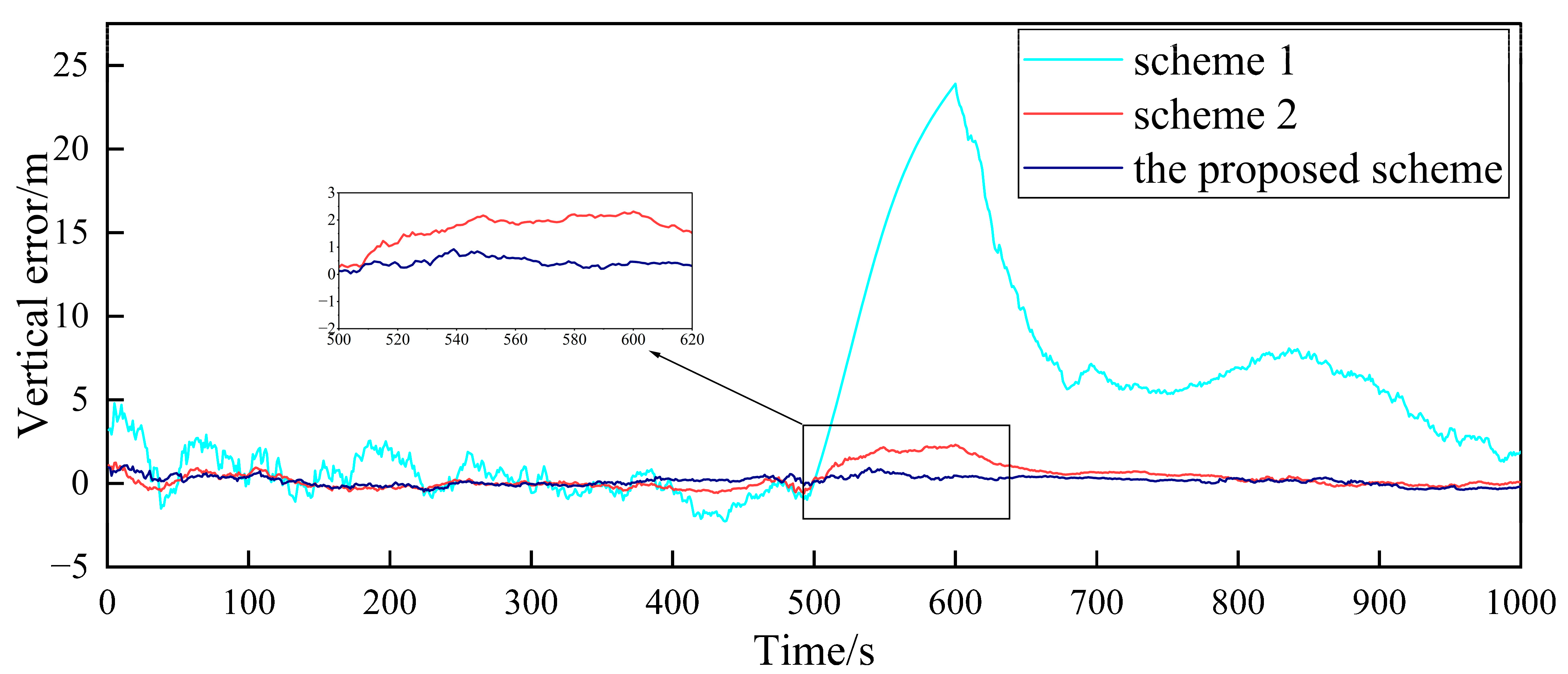
| UAVs | Items | Data |
|---|---|---|
| Leader UAVs | INS/GPS eastward error | 1 |
| INS/GPS northward error | 1 | |
| INS/GPS vertical error | 1 | |
| UWB ranging noise | 0.03 | |
| Follower UAVs | GPS eastward error | 10 |
| GPS northward error | 10 | |
| GPS vertical error | 10 | |
| Gyro drift | 1 | |
| Gyroscope random walk | 0.1 | |
| Accelerometer bias | 100 | |
| Accelerometer random walk | 5 | |
| UWB ranging noise | 0.03 |
| Positioning Error | ||||||
|---|---|---|---|---|---|---|
| Scheme 1 | Scheme 2 | The Proposed Scheme | Scheme 1 | Scheme 2 | The Proposed Scheme | |
| Eastward | 2.10 | 0.45 | 0.41 | 1.68 | 0.35 | 0.33 |
| Northward | 2.43 | 0.45 | 0.40 | 1.99 | 0.36 | 0.32 |
| Vertical | 1.85 | 0.27 | 0.25 | 1.44 | 0.20 | 0.20 |
| Positioning Error | ||||
|---|---|---|---|---|
| Scheme 2 | The Proposed Scheme | Scheme 2 | The Proposed Scheme | |
| Eastward | 1.84 | 0.95 | 0.54 | 0.40 |
| Northward | 1.34 | 0.76 | 0.49 | 0.36 |
| Vertical | 1.77 | 0.50 | 0.49 | 0.26 |
| Simulation | Elapsed Time/s | ||
|---|---|---|---|
| Scheme 1 | Scheme 2 | The Proposed Scheme | |
| No fault | 0.23 | 0.94 | 0.95 |
| Fault | 0.25 | 0.96 | 0.98 |
Disclaimer/Publisher’s Note: The statements, opinions and data contained in all publications are solely those of the individual author(s) and contributor(s) and not of MDPI and/or the editor(s). MDPI and/or the editor(s) disclaim responsibility for any injury to people or property resulting from any ideas, methods, instructions or products referred to in the content. |
© 2023 by the authors. Licensee MDPI, Basel, Switzerland. This article is an open access article distributed under the terms and conditions of the Creative Commons Attribution (CC BY) license (https://creativecommons.org/licenses/by/4.0/).
Share and Cite
Zhang, P.; Ma, Z.; He, Y.; Li, Y.; Cheng, W. Cooperative Positioning Method of a Multi-UAV Based on an Adaptive Fault-Tolerant Federated Filter. Sensors 2023, 23, 8823. https://doi.org/10.3390/s23218823
Zhang P, Ma Z, He Y, Li Y, Cheng W. Cooperative Positioning Method of a Multi-UAV Based on an Adaptive Fault-Tolerant Federated Filter. Sensors. 2023; 23(21):8823. https://doi.org/10.3390/s23218823
Chicago/Turabian StyleZhang, Pengfei, Zhenhua Ma, Yin He, Yawen Li, and Wenzheng Cheng. 2023. "Cooperative Positioning Method of a Multi-UAV Based on an Adaptive Fault-Tolerant Federated Filter" Sensors 23, no. 21: 8823. https://doi.org/10.3390/s23218823






